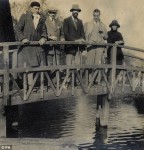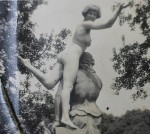 A heretofore unseen collection of diaries, letters and pictures from two of the younger, lesser known members of the Bloomsbury set, the group of artists and writers including Virginia Woolf and EM Forster who came to typify the bohemian lifestyle of inter-war British intellectuals, is going on display at Cambridge University’s King’s College archive center.
A heretofore unseen collection of diaries, letters and pictures from two of the younger, lesser known members of the Bloomsbury set, the group of artists and writers including Virginia Woolf and EM Forster who came to typify the bohemian lifestyle of inter-war British intellectuals, is going on display at Cambridge University’s King’s College archive center.
Rosamond Lehmann was a successful novelist in the 30s Her archives include manuscripts and notes from many of her works, plus a huge amount of correspondence from the likes of EM Forster, Siegfried Sassoon and Virginia Woolf, and poems from luminaries of the era, including her lover, poet laureate Cecil Day Lewis, father of Daniel.
Writer Frances Partridge‘s collection includes her extensively detailed diaries, lectures, notes, and not only her own photograph albums but also those of biographer and critic Lytton Strachey and painter Dora Carrington, whose doomed relationship was depicted in the movie Carrington by Jonathan Pryce and Emma Thompson.
A University spokesman said the articles showed a fascinating glimpse of the lifestyles, interests and opinions of a unique group of women who flourished between World War I and World War II.
He said the women voiced political opinions and enjoyed university education while many of their contemporaries would not have benefited from the same opportunities.
Archivist of King’s College, Cambridge, Patricia McGuire, said of Lehmann and Partridge: “These two women in particular had all the benefits of the inter-war era.
“They were allowed to come to Cambridge at a time when women were finally earning some rights in Cambridge.
“In 1921 they were allowed titular degrees, which were not the same as university membership but it was a big step forward for women in education, and women were getting the vote if they had a university degree or were landowners so it was a wonderful time in women’s rights.”
 Their vie bohème, as it so often is, was made possibly by the financial independence of the people fortunate enough to live it. You can see what a privileged life they really lived in these letters and pictures. Nannies and country homes are involved. Also nudity. Dora Carrington posed nekkid like a statue, and Frances Partridge is topless kind of a lot, actually. Only Virginia made a point of staying clothed in pictures.
Their vie bohème, as it so often is, was made possibly by the financial independence of the people fortunate enough to live it. You can see what a privileged life they really lived in these letters and pictures. Nannies and country homes are involved. Also nudity. Dora Carrington posed nekkid like a statue, and Frances Partridge is topless kind of a lot, actually. Only Virginia made a point of staying clothed in pictures.
In one of the sadder letters is from Virginia Woolf’s sister Vanessa Bell telling her friend that it’s just a matter of time before they find the body and officially announce her death, but she knows from the letters Virginia left behind and her footprints found by the riverside that her sister has killed herself.